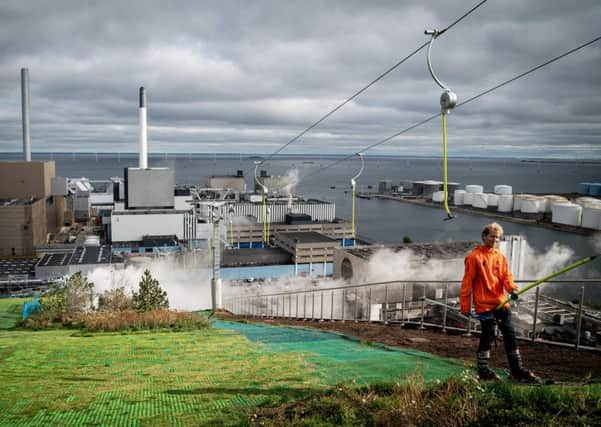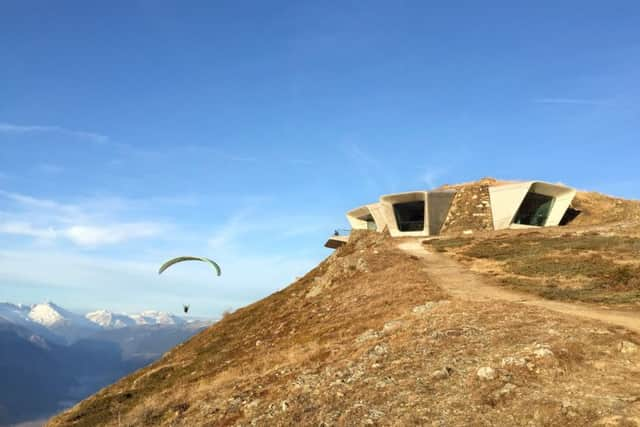Skiing and great architecture don’t often meet, but when they do the results can be spectacular


Bjarke Ingels, founder of BIG, the architecture practice that designed CopenHill, describes it as an example of “hedonistic sustainability”. Part of its purpose, he recently told Dezeen magazine, is to demonstrate that “a sustainable city is not only better for the environment – it is also more enjoyable for the lives of its citizens”.
Ski areas aren’t typically associated with innovative architecture. In most European resorts, the vernacular of the traditional Alpine ski chalet is almost omnipresent. Nothing wrong with all those sensible, snow-shedding A-frame roofs and picturesque painted shutters, natürlich, but after you’ve visited a few of them it can be tricky to tell the ski resorts of Austria, France, Switzerland and Italy apart. Meanwhile, over in North America, it’s getting to the point where the base stations of major resorts – increasingly owned by the same few parent companies – have actually started looking like clones of each other, right down to the tastefully painted wood panelling. When architecture students go on field trips, they don’t typically make a beeline for the mountains.
Advertisement
Hide AdAdvertisement
Hide AdHaving said all that, however, not all ski resorts are architectural dead-zones, so if you’re looking to book a ski trip to somewhere with a little more in the way of architectural interest this winter, here are a few destinations to consider.


Aspen, Colorado. Commonly held to be the mountain bolthole of choice for the trust-funded Jeeps-and-chinos brigade, architecturally speaking Aspen is considerably less conservative than the bulk of its clientele. Thanks to the Chicago industrialist and Bauhaus enthusiast Walter Paepcke, who bankrolled the town’s development after the Second World War, and in particular his decision to employ the Austrian architect Herbert Bayer, Aspen is home to some vintage Bauhaus marvels, notably the Bayer-designed Aspen Institute campus.
Avoriaz, France. It’s common to see people taking the gondola up to 1,800m Avoriaz for the first time doing a cartoon-style double-take as the mighty high-rises designed by Jacques Labro in the 1960s hove into view. Despite their overwhelming size and unusual, asymmetric shapes, however, they still seem to belong to their high-mountain environment, thanks to their sympathetic wood and slate exteriors.
Banff, Canada. Whether you love or loathe its faux-baronial style, the Fairmont Banff Springs is undeniably dramatic. An almost ridiculously grand monolith, replete with turrets, surrounded by pine forests and backed by mountains, it looks a bit like a child’s drawing of a fairlytale castle. Built in 1888 at the behest of the General Manager of the Canadian Pacific Railway, William Cornelius Van Horne, long before recreational skiing was a thing, then rebuilt in 1926 following a fire, it’s within easy striking distance of the Mount Norquay, Lake Louise and Sunshine Village ski areas.
Kronplatz, Italy. Skiers at the Italian resort of Kronplatz are spoiled for choice when it comes to intriguing buildings. In 2015, Zaha Hadid built her Messner Mountain Museum Corones on the ski area’s summit plateau, which famously looks like an alien spacecraft that’s crashed into a pile of rubble. Then, earlier this year, Lumen, South Tyrol’s new museum of mountain photography, opened nearby. Designed by local architect Gerhard Mahlknecht, it occupies a stylishly repurposed cable-car building at an altitude of 2,275 metres and boasts a spectacular cantilevered restaurant.
Le Brassus, Switzerland. It isn’t scheduled to open until 2021, but the Hôtel des Horlogers in the Swiss resort of Le Brassus should be worth the wait. Designed by Bjarke Ingels of CopenHill fame, the building’s front elevation will incorporate a ski slope zig-zagging down from its roof, allowing guests to ski straight out of their rooms and off to the slopes. Or, if you can’t be bothered with the resort, you could just ski the hotel roof all day and get room service whenever you feel like it.